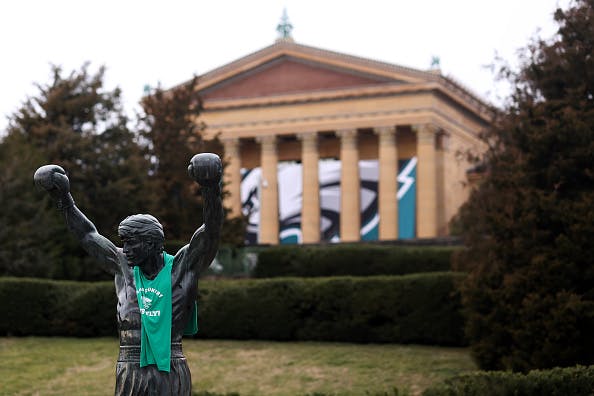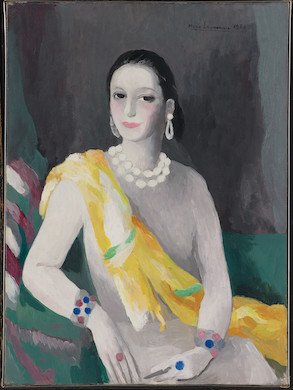From Rocky to Rodin, Philadelphia’s Cultural Offerings Run the Gamut
While A. Thomas Schomberg’s bronze portrait of Sylvester Stallone as the cinematic character that made him famous gets much more attention than the offerings of the masters, art lovers have plenty to choose from.

Should you want to spend a brisk fall weekend in the City of Brotherly Love, Philadelphia’s cultural institutions have some offerings that are, at the least, diverting; at their best, they’re sublime. Be prepared, though, to queue up outside the Philadelphia Museum of Art — no, not for anything inside its august halls. Rather, it would be for “Rocky” (1980), A. Thomas Schomberg’s larger-than-life bronze portrait of Sylvester Stallone as the cinematic character that made him famous.
You might recall the brouhaha that resulted upon Mr. Stallone gifting the piece to Philadelphia. The stairs leading up to the museum figured in a memorable scene from the original “Rocky,” and the actor thought Mr. Schomberg’s sculpture — really, a prop from “Rocky III” — was its own kind of homage.
Arts professionals fretted that placing “Rocky” outside one of the country’s great museums would be a sign that the institution was ratifying kitsch. City officials, eager to place the work in a public venue, argued that the sculpture wasn’t “art as it has been defined by aesthetic standards,” and that won the day. What Messrs. Stallone and Schomberg made of this backhanded vote of support is a good question.
“Rocky” is a popular draw, occasioning lineups of tourists, curiosity seekers, and movie fans wanting photo ops. All the while, Auguste Rodin’s “The Thinker” (1902-04; cast 1919), ensconced on Benjamin Franklin Parkway just a hop, skip, and jump from Rocky Balboa, can’t get any love — unless the stray pigeon counts. Perhaps Rodin’s mascot for the museum that bears the sculptor’s name is mulling what, exactly, the role of artistic worth might be in a culture dominated by celebrity.
Two eye-catching banners on the exterior of the Philadelphia Museum herald celebrities of another sort. One of them is an internationally beloved Dutch painter, Johannes Vermeer; the other is James McNeill Whistler or, even better, his mother. Although there were a healthy number of visitors to the museum during the weekend on which I visited, few of them saw fit to stop by “The Artist’s Mother: Whistler and Philadelphia.” True, the exhibition is small in scale and selective in concentration, but, come on: We’re talkin’ “Arrangement in Grey and Black No. 1: Portrait of the Artist’s Mother” here.

On loan from the Musee d’Orsay at Paris, the canvas commonly known as “Whistler’s Mother” hasn’t been seen at Philly since it was exhibited at the Pennsylvania Academy of Fine Arts in 1881. I caught the exhibition toward the end of its run — the show closes this weekend — so the initial buzz might have passed.
Still, over the two days I wandered through the museum, few people seemed to take note of the picture and its masterful array of pearlescent grays and velvety blacks. The curators surrounded Whistler’s picture with depictions of mothers by other artists, the best of the bunch being by the underrated Henry Ossawa Tanner and the almost forgotten Sidney Goodman.
Perhaps “Arrangement in Grey and Black No. 1: Portrait of the Artist’s Mother” has lost its currency as an iconic image on the scale of “The Scream” by Edvard Munch or “Girl With a Pearl Earring.” Knowing full well the box office draw of Meneer Vermeer, the good folks at the Philadelphia Museum are hoping against hope that a painting in its collection long considered a “Copy After Vermeer” might be the real thing. Before the picture is sent out for extensive research, gallery-goers can decide for themselves by visiting “Vermeer? A Conversation Through Time” until the end of 2023.
Blame for this goes to an independent scholar who formerly worked at Amsterdam’s Rijksmuseum, Arie Wallert. At a symposium held during March of this year, Mr. Wallert stated that the Philadelphia picture is the real thing. “Copy of Vermeer” was considered a genuine Vermeer up until 1927, when “The Guitar Player” (c. 1672), now in the collection of Britain’s Kenwood House, was rediscovered and given a quick stamp of approval.
Will the copy — which is similar to the Kenwood painting save for those fetching ringlets of hair — find approval upon restoration? My eye says “no”: the gray wall behind the title figure is unlike anything else in the canon and Vermeer wasn’t known to make copies of his own work. Still, it’s hard to begrudge the Philadelphia Museum its wishful thinking.
Down the parkway past Rocky and Rodin, the Barnes Foundation is in the process of being discreetly queered. This phrase, ahem, is lifted from the press release for “Marie Laurencin: Sapphic Paris,” the first U.S. retrospective of paintings by a figure who was an indispensable component of the Parisian art scene. Not only did Laurencin (1883-1956) pal around with the likes of Pablo Picasso, Georges Braques, Francis Picabia, and Guillame Appolinaire, but she was declared among “the best French women painters” by no less an eminence than the man himself, Albert C. Barnes.
The institution that bears his name has devoted itself in recent years to “exploring the achievements of significant but underrecognized women working in the European modernist vanguard.” The results have been invariably interesting and, in the case of 2018’s Berthe Morisot retrospective, revelatory. How “Sapphic Paris” will fare by the standards of Philadelphia’s city elders — you remember, “not art as it has been defined by aesthetic standards” — remains to be seen, but the Barnes Foundation should be commended for braving another Modernist byway worthy of recognition.

